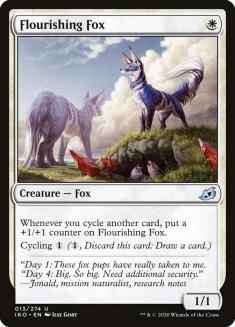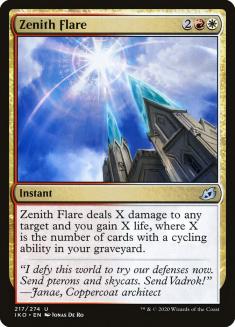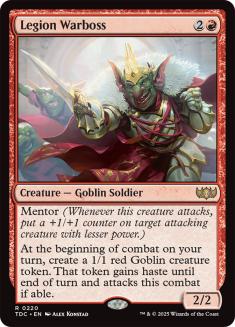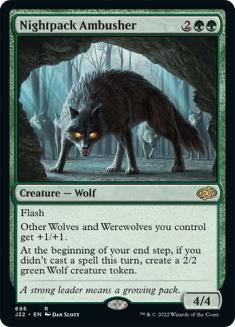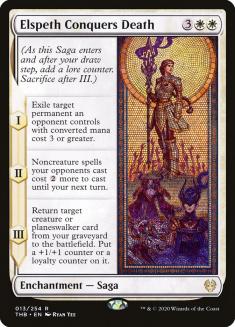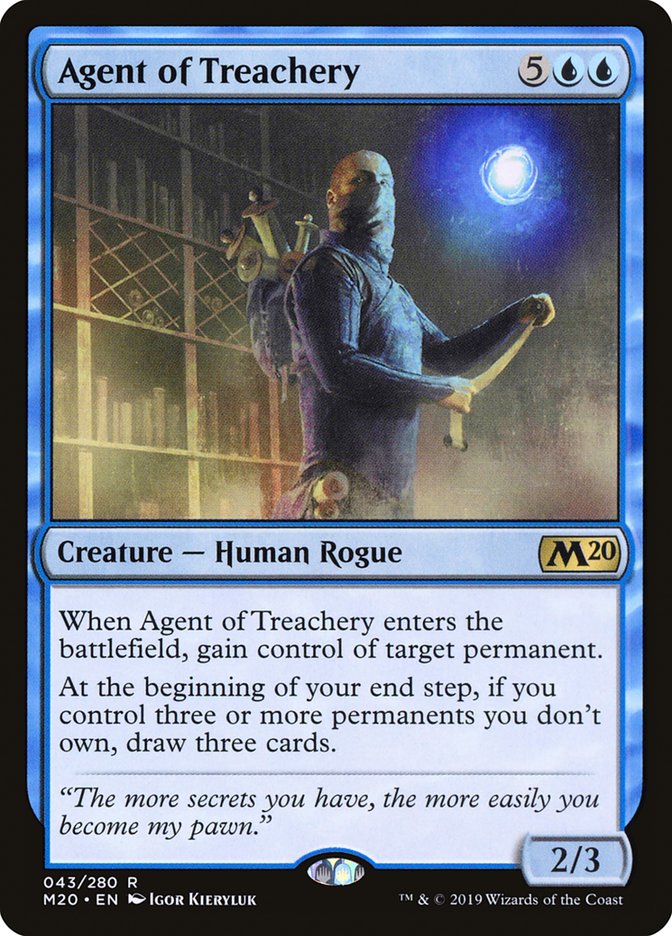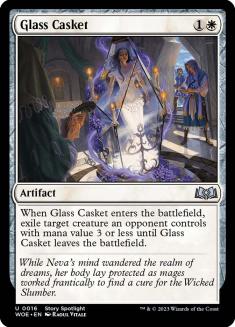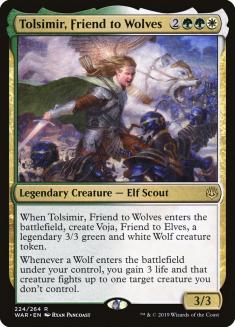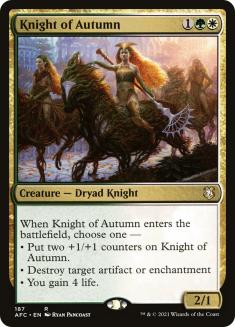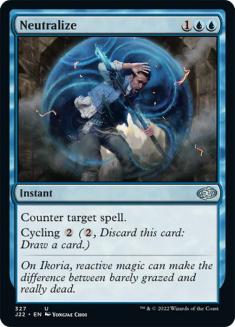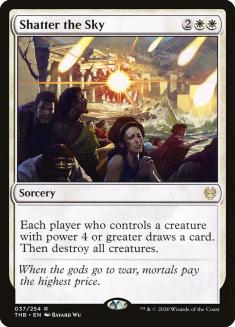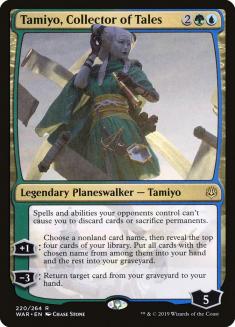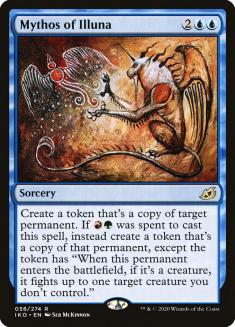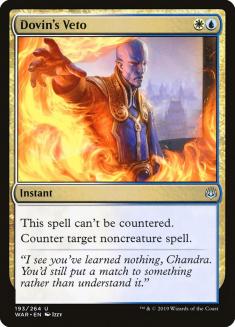Last week, I talked about how the combo of Yorion, Sky Nomad alongside Fires of Invention was one of the best things you could do in Ikoria Standard. This week, I’m going to talk about a Yorion deck that doesn’t have Fires of Invention — Yorion Bant Control.
If the combo of Yorion, Sky Nomad with Fires of Invention is so good (and it is, I promise), then why play Yorion Bant Control instead of Yorion Four-Color Fires? This is for two reasons:
The first reason is cycling decks. I found that the four-color version had some issues with the deck, as its removal of choice (Omen of the Forge, Deafening Clarion) was not fast enough to kill Flourishing Fox on the draw, and you didn’t have any answers to Zenith Flare. You could gain some life, of course, but it wasn’t unreasonable for them to draw two Zenith Flares over the course of the game and then you were just dead.
The second, and much more important reason, is the emergence of Yorion Jeskai Lukka. The four-color version was a deck that hoped to go over the top of what anyone else was doing, and for the most part it succeeded, but there’s always a bigger fish, and that’s Jeskai Lukka. Given that there’s now a widely popular deck that will consistently go over the top of you, you cannot play a goldfishing match against them — you need to interact to be able to win, or you will be outclassed every time. Interaction means counterspells and counterspells mean Fires of Invention becomes a liability.
Thus, enter Yorion Bant Control.
At first, I started with the list Piotr Glogowski played in the ELEAGUE Showdown:
Creatures (6)
Planeswalkers (9)
Lands (36)
Spells (29)

I soon found out that, while many of the cards in this deck were the same as in Yorion Four-Color Fires, it played out very differently. Four-Color Fires was a tapout deck and this was a counterspell deck; as an analog to similar decks in the past, Yorion Four-Color Fires was an Esper Midrange deck, whereas Yorion Bant Control was Azorius Control.
In most games, the Four-Color version had no choice but to enter a war of haymakers — it would play a powerful card (or multiple) every turn of the game, hoping that its powerful card in the end was the most powerful. The Bant control version, on the other hand, always offers you possibilities. You can either enter that haymaker war or you can try to play a reactive game and maneuver small advantages into a position where you inevitably win, often with recurring counterspells through Tamiyo, Collector of Tales.
In practice, this means two things. First, this deck is weaker against aggressive strategies (fewer removal spells and early blockers), but stronger against the rest of the field — it has less dead air in the mid- to late-game and plays counterspells that can stop you from losing to Expansion // Explosion; Zenith Flare; Lukka, Coppercoat Outcast; or similar cards.
Second, this deck is significantly harder to play. They say with great power comes great responsibility, and it’s definitely true here. You have the power to play two types of games (tap-out or counterspells), and therefore you must choose which game you’re going to play every time. Usually, once you choose a style, you’re locked into it for a while, so choosing the wrong one can have disastrous consequences.
For example, you often have the choice between casting Teferi, Time Raveler / Narset, Parter of Veils or keeping Neutralize, Mystical Dispute, or Dovin’s Veto up. If you choose to cast your planeswalker and your opponent has a good response, this often puts you in a position where you must then tap out again to answer whatever they deployed and then at that point the game has turned into a tap-out game and God knows when you’ll be able to use your counterspell. Similarly, if you wait with mana up and they do nothing, or have an instant-speed threat to deploy, it gets more and more dangerous to tap out as time goes on and you usually need to wait until you have at least six mana.
As a general rule, you would like to play the counterspells game if possible. The farther ahead in the game you are, the more likely it is you’ll be able to do this. So, if you’re winning the game, don’t feel like you have to make something happen — just sit back and deal with what they cast. If you’re losing the game, however, then you must take risks; tap out and hope what they cast isn’t as good as what you’re casting.
Past that, the deck has the same grindy elements that all Yorion decks do — cast some planeswalkers, some Omen of the Sea, Elspeth Conquers Death, blink everything with Yorion, etc. It’s virtually impossible to exhaust you of cards, since Teferi can bounce back Yorion and reset everything, and Tamiyo and Elspeth Conquers Death can bring back Yorion if it dies.
I made a couple of changes and this is the deck I submitted for the latest MagicFest Online:
Creatures (8)
Planeswalkers (10)
Lands (37)
Spells (25)

The main difference between my list and other lists is the lack of Aether Gust. I honestly don’t understand why you would maindeck Aether Gust right now — in fact, I don’t even like it that much as a sideboard card. Maindeck Aether Gust is a card I only want versus one deck (outside of fringe decks like Gruul combinations or Mono-Red, which I haven’t seen in a long time) — Temur Reclamation.
That’s it. It’s okay against Yorion Jeskai Lukka decks, but it’s not very good in the mirror, it’s not very good versus any build of Jeskai Fires, it’s not very good versus any Rakdos Sacrifice builds, and it’s horrible versus most Lurrus-based builds. You will find targets for Aether Gust against most decks, but there are not many and they often aren’t the best, and against almost any deck where Aether Gust is good (including Temur Reclamation) a regular counterspell would be better.
In the sideboard, things change a little bit. The main reason for this is Legion Warboss. Having Aether Gust means you can play a cheap answer to Legion Warboss that isn’t a dead card if they don’t draw it. It’s also quite good as an answer to Nightpack Ambusher, which can otherwise be a problematic card for you to deal with. If it wasn’t for those two cards, I would have zero Aether Gusts in my 75 95, and I believe that both cards are in decline right now (various takes on Jeskai Fires found a predator in the Yorion decks and Nightpack Ambusher’s role is sort of replaced by Shark Typhoon, so it shows up in smaller numbers).
I thought my list was good, but there were some things I would change. The first is adding a fourth copy of Shark Typhoon.
I didn’t like the card very much in the four-color version, so I chose to cut one copy from Kanister’s list, but after playing more I believe this was a mistake. Since this deck has more counterspells, the instant-speed aspect of Shark Typhoon is a lot more important. It cycles early on to find you land drops and fuel Uro, Titan of Nature’s Wrath; it pressures planeswalkers; it defends you from opposing Shark Typhoons; and it eventually kills your opponent. It’s also a card that you often want to name with Tamiyo, so having the fourth copy increases your chances of hitting it there as well. It’s almost always better to cycle Shark Typhoon than to cast it in this deck.
The second is having access to four copies of Mystical Dispute between deck and sideboard.
I ended up cutting some Disputes because I didn’t want to make my deck weak to a resolved Teferi, Time Reveler, but the outcome was that my deck was still weak to Teferi and it was just easier for them to resolve it. It’s true that Mystical Dispute can become useless later in the game versus something like Temur Reclamation or Fires of Invention, but the fact that Yorion exists means that if you win the early-game and get to the mid-game in a dominant position, it’s not going to matter if you have a dead card later on.
Mystical Dispute is excellent to win the early-game, as it lets you force through your planeswalkers or play them while stopping your opponent from resolving theirs. Obviously it depends on your hand, but my default is to counter Growth Spiral and Uro, Titan of Nature’s Wrath when I can, and I also counter Omen of the Sea some of the time.
This is the list I would play right now:
Creatures (6)
Planeswalkers (10)
Lands (37)
Spells (27)

Sideboarding
Similarly to the Four-Color version, sideboarding with this deck is pretty intuitive — the cards are clearly good versus aggro or versus control and you sideboard the same versus most of the macro archetypes.
VS Lurrus Boros Cycling
Out:
In:
There are two ways you can lose games to this deck — Flourishing Fox and Zenith Flare. Glass Casket is by far the best answer to the Fox, so I think you should just play four copies of that card, and for Flare you have counterspells. Given that Aether Gust doesn’t actually solve either of your problems (and has few targets overall), I don’t like it in this matchup.
Mystical Dispute is a pretty bad card against the Boros version, but I think it’s still better than Dovin’s Veto, since it can counter Lurrus of the Dream-Den or one of the two-drops if they cast it Turn 3 — they don’t often have seven mana, and even when they do, they sometimes cycle earlier in the turn before casting Zenith Flare, so you can still get it.
VS Lurrus Jeskai Cycling
Out:
In:
This is the same, except that Mystical Dispute actually has discounted targets in Improbable Alliance and their own potential sideboarded counterspells, which I think makes it better than Neutralize.
VS Jeskai Fires (all variants)
Out:
In:
There can be some variation in Jeskai Fires lists but this is what I generally do. I believe this matchup plays out similarly to the Jeskai Fires versus Azorius Control matchup from the past — counterspells are excellent Game 1 but not as reliable in Games 2 and 3. Because of that, I don’t even bring in Dovin’s Veto and I expect to play a more tap-out game, which makes cards like Knight of Autumn and Mythos of Illuna good. Mythos of Illuna, in particular, is excellent as a way to make you catch up to a resolved Fires of Invention. You just copy their Fires and cast an Elspeth Conquers Death or a Knight of Autumn, and then you’ll have a very explosive next turn.
VS Yorion Jeskai Lukka
Out:
In:
Originally, I thought this was going to be a very bad matchup, but after playing more I’d say it’s about even. They have the more powerful cards, but you have counterspell and acceleration, which means you can double-spell them much more easily if you stop Fires of Invention from resolving. At the MagicFest Online last weekend, I played against I believe seven copies of the deck and my record was 6-1 (though one opponent timed out when they would have beaten me given more time, so a gentleman’s 5-2).
This is a matchup in which, if you try to play the haymakers game, they will usually beat you. Your best chance is to counter their big spells, but for that you need Teferi not to resolve. They are still an 80-card deck, so sometimes it’s safe to tap out because they just haven’t drawn the cards to punish you, but the problem is that you can’t know if that’s the case or not before it’s too late. Tamiyo isn’t a bad card in the matchup exactly, but since tapping out early can be so costly, I think it’s fine to take one out.
VS Yorion Bant Control
Out:
In:
The matchup plays out a bit differently here, but I sideboard the same way. They have fewer ways of punishing you for tapping out, so you can be more adventurous — it could be right, for example, to run a Knight of Autumn early on to kill an Omen of the Sea. Teferi is still an issue, of course, but you’re usually fine with them resolving a couple of spells, whereas against Yorion Jeskai Lukka, if they manage to resolve Fires and untap with it and a Teferi on the battlefield, you’re usually dead on the spot.
Since tapping out isn’t as much of an issue, Tamiyo becomes better. That said, I simply don’t know what to take out. It’s very unlikely that taking Tamiyo out is correct, but it’s what I’ve been doing for the moment because of the lack of an alternative.
In this matchup (and in most other matchups where Mystical Dispute is involved) I would recommend that you both counter the acceleration and try to protect yours from being countered. For example, if you’re on the play and they lead with a Temple, you should almost always main-phase Growth Spiral so that they cannot Dispute it.
VS Temur Reclamation
Out:
In:
I think this is another even-ish matchup. Their best draws are unbeatable, but you can certainly compete with their average draws, and your planeswalkers are both very good.
The best route to winning the game is usually to stick one or both of them. In Game 1 of this matchup, you should strongly consider just running Elspeth Conquers Death in there, even if they have no targets, as the second chapter is extremely good versus them and they can rarely punish you (if they cast Reclamation, you can use Yorion to blink the Elspeth Conquers Death and get rid of it). As usual, go after their mana; you should almost always Dispute a Growth Spiral or an Uro, Titan of Nature’s Wrath if you can.
After sideboard, they get more counterspells and Fry to answer your planeswalkers, so this plan isn’t as reliable, but you get some more tools too. Mythos of Illuna is an experiment — originally I had one Glass Casket to deal with Shark tokens, but Mythos also deals with a Shark token (by copying it) and it can be very good in random situations (such as if they resolve a Reclamation or if you have something of your own you want to copy). Mythos is also a sorcery, which means it works with Teferi. If you pass the turn and they make a giant Shark, if your answer is Glass Casket you give them the opportunity to immediately kill Teferi before you get rid of their creature, but if your answer is Mythos of Illuna, then you can copy the Shark at instant speed (assuming you’ve used the +1 ability on Teferi) and block it.
I’m not convinced Knight of Autumn is good here, since you mostly don’t want to tap out, but I’ve found that sometimes the game becomes a tap-out war even if that’s not the direction you want it to go, and then having Knight is a good insurance policy. Sometimes you can also just cast it on Turn 3 to pressure them — they usually like to take a lot of damage from their lands to keep mana up in case something happens, so Knight can actually threaten to close out the game in four or even three attacks (especially aided by Shark tokens). If I had something else in my sideboard to bring in, I’d maybe not bring it in the Knights, but with this configuration I think I’d rather have them.
VS Obosh Rakdos Sacrifice
Out:
In:
They’re a fast and unforgiving deck, so you need early action. If you keep a bad hand you will just die the turn they cast Obosh, the Preypiercer. After sideboard it gets much better for you, as you get more cheap interaction and they don’t gain nearly as much.
I’ve seen some people bring in Aether Gust in this matchup, since they have a guaranteed target in Obosh itself (plus randomly Mayhem Devil), but I don’t like it. I think it’s too narrow and there’s a reasonable chance they even cut Mayhem Devil from their deck post-sideboard. If they’re playing a version with a lot more red cards, Aether Gust becomes good and you can take out Neutralizes for it.
VS Lurrus Rakdos / Lurrus Orzhov
Out:
In:
Elspeth Conquers Death only has one target and that’s not enough even if they’re guaranteed to draw it. This means there are just too many cards to take out and you have to end up with cards like Mythos of Illuna in your deck (at least in the configuration I’m running). It’s certainly not a good card, but it’s something you can play and impact the battlefield in some capacity, so I think it’s better than the other cards. Agent of Treachery is the best of the bad cards, since it can steal Witch’s Oven.
All in all, I believe Yorion Bant Control is both one of the best and one of the most fun decks in the format. I’m not going to lie, the mirror is kinda miserable, but it can also be very challenging to play and very rewarding when you take the correct lines. If you like control decks that smother your opponent in gradual card advantage until you eventually have more counterspells in hand than they have cards, this is the deck for you.
Just make sure you practice with it because it is not easy to play.

